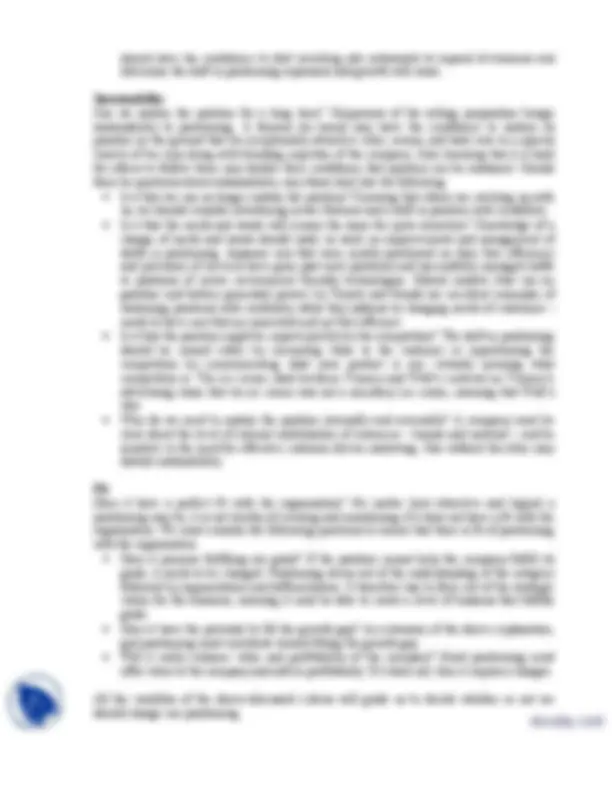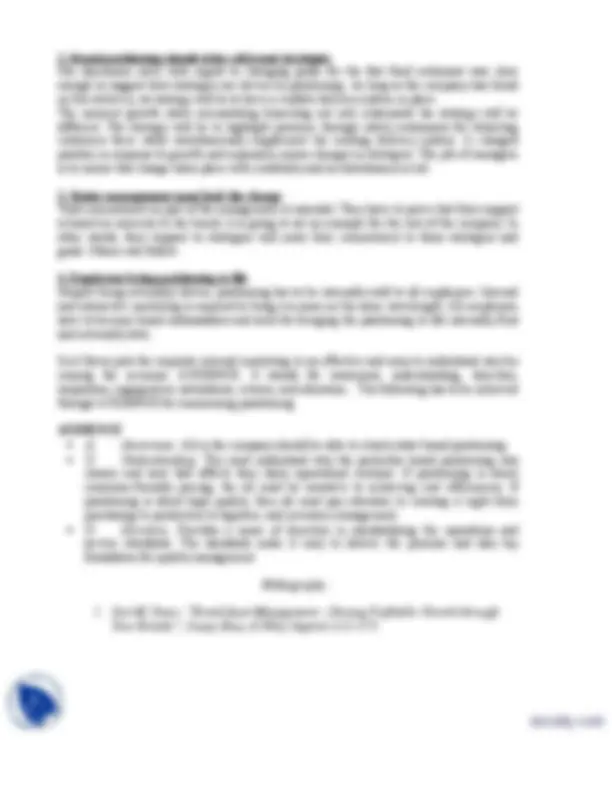




Study with the several resources on Docsity

Earn points by helping other students or get them with a premium plan


Prepare for your exams
Study with the several resources on Docsity

Earn points to download
Earn points by helping other students or get them with a premium plan
Community
Ask the community for help and clear up your study doubts
Discover the best universities in your country according to Docsity users
Free resources
Download our free guides on studying techniques, anxiety management strategies, and thesis advice from Docsity tutors
This lecture handout is for Brand Management. It was designed and distributed by Prof. Nirmohi Jonnalagadda at KLE University. Its main points are: Positioning, Price, Premium, Competetion, Benefit, Uniqueness, Shift, Value, Target, Brand, Management
Typology: Exercises
1 / 4

This page cannot be seen from the preview
Don't miss anything!



Lesson 19 POSITIONING – GUIDING PRINCIPLES Introduction This lecture is devoted to the guiding principles, as Scot Davis puts them, relating how to reposition and maintain an established position^1. Five principles are discussed hereunder:
1. Update your position as necessary Before updating positioning, one must take a look at the present position to see if it is still relevant to the target audience, fulfills needs, customer shifts, market dynamics, and company goals. Generally speaking, the moment you realize that there are unmet needs, you must start thinking about re-positioning the brand. According to Davis, it takes about three to five years to change the position. There are five different criteria to judge if there is need for updating2. The criteria are illustrated graphically with the help of figure 23 on the next page. Value Does the target market value our positioning? If it does, then there is no need to change the positioning. If it does not, then there should be a cause for concern about changing the positioning of our brand. To realistically assess the situation, we need to ask ourselves the following questions: - Do customers feel motivated to buy? Any drop in the level of sales should indicate a corresponding drop in motivation. However, before waiting for that eventuality, we should conduct research from time to time to assess the level of customers’ motivation to buy. - Do they really prefer over competition? Continued preference of our brand is an indication that we do not change the positioning. Our research about how our brand stacks up against competition is a fair guide to gauge if a shift in positioning is required. - Do they really feel getting benefits? Should there be a change in customers’ perception about getting the expected benefits; the time is then ripe for studying the evolving changes and acting on keeping the brand current and contemporary. - Do they feel their needs are being met? This is an extension of the preceding question and requires finding out any unmet needs that may have arisen due to evolving changes. Does the market allow us to charge a premium? If our brand is enjoying the pinnacle, then it should enjoy price premium with indication of not causing a shift in positioning. However, continual research should send us signals about the need to cause desired shifts in a way that we maintain product credibility and the pinnacle. - Does the positioning cut across segments? A strong position should take us into a multi- segmental situation. If it does not, then we may look into the reasons for weak positioning and the need to cause a shift. Uniqueness Does the position make our brand unique and exclude competition? The moment customers stop considering our brand as unique, we should have a cause for managing a shift in positioning. We should consider the following questions: - Do customers consider our brand positioning as something really unique, different from others?
2. Brand positioning should drive all brand strategies Our discussion early with regard to changing goals for the fast food restaurant was clear enough to suggest how strategies are driven by positioning. As long as the company has thrust on free delivery, its strategy will be to have a credible delivery system in place. The moment growth starts necessitating branching out into restaurants the strategy will be different. The strategy will be to highlight presence through utility restaurants for attracting customers there while simultaneously supplement the existing delivery system. A changed position in response to growth and expansion causes changes in strategies. The job of managers is to ensure that change takes place with credibility and no disturbances at all. 3. Senior management must lead the charge Total commitment on part of the management is essential. They have to prove that their support is based on sincerity to the brand; it is going to set an example for the rest of the company. In other words, their support to strategies will mark their commitment to those strategies and goals. Others will follow. 4. Employees bring positioning to life Despite being externally driven, positioning has to be internally sold to all employees. Internal and interactive marketing is required to bring everyone on the same wavelength. All employees have to become brand ambassadors and work for bringing the positioning to life internally first and externally later. Scot Davis puts the requisite internal marketing in an effective and easy-to-understand way by coining the acronym AUDIENCE. It stands for awareness, understanding, direction, inspiration, engagement, naturalness, criteria, and education. The following has to be achieved through AUDIENCE for maximizing positioning: AUDIENCE - A: Awareness: All in the company should be able to clearly state brand positioning. - U: Understanding: Thy must understand why the particular brand positioning was chosen and how that affects their daily operational routines. If positioning is about consumer-friendly pricing, the all must be sensitive to achieving cost efficiencies. If positioning is about high quality, then all must pay attention to creating it eight from purchasing to production to logistics, and inventory management. - D: Direction: Provides a sense of direction in standardizing the operations and service standards. The standards make it easy to deliver the promise and also lay foundation for quality management. Bibliography: 1. Scot M. Davis: “Brand Asset Management – Driving Profitable Growth through Your Brands”; Jossey-Bass, A Wiley Imprint (115-127)